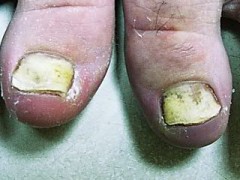It is usually due to fungal infection of the toe or finger webs, under a hot and humid environment, which later spreads onto the nails. Sometimes the fungus may directly invade the nails.
The infection starts from the free ends, or the lateral sides, and extends towards the matrix. Tinea unguium is mainly a problem of the adults, and only rarely affects children under the age of 10.
Signs
The affected nail becomes thickened, loses its lustre and appears yellowish-grey in colour. The nail material is no longer hard and is brittle, with crumbled bits coming off at the distal free end. Part of, or even the whole nail may be separated from the nail bed (onycholysis).

There may be co-existing signs of fungal skin infection in the nearby skin.
Clinical Diagnosis
With good experience, the doctor may be able to diagnose this easily from the appearance. If a definitive diagnosis is required, or when it is confused with other possible causes, then a sample can be obtained by cutting off some of the nail and sent to the laboratory for examination under the microscopy, or for culture.
Many other skin problems may have similar signs in the nails, especially psoriasis where the nail appearance can be very similar. This is when laboratory test may become necessary.
Treatments
The growth of a nail is rather slow. To grow from the matrix to the distal end, it takes 4 to 6 months for the fingernails, and 6 to 12 months for the toenails. Therefore to cure a nail that is infected by fungus, all treatments will require a course of a few months, so as to allow the infected nail to grow out and replaced by new un-infected nail.
External Cream
The fungi exist deep inside the nail material, the nail bed and the matrix. Cream cannot deliver the active ingredients to penetrate deep enough, and is therefore rather useless.
Medicated Nail Lacquer
Active anti-fungal ingredients can be added into nail lacquer, which is painted onto the nail surface and let dry. This allows a much longer contact and the ingredients can have long enough time to penetrate more into the nail material. Either because of incomplete penetration, or the presence of fungi in the matrix, the effectiveness is still only about 60 - 70% after a treatment period of 6 months.
The advantage of this treatment is that it has almost no side effects; the use is simple; and only needs to be painted on once a week.
It is probably the first choice of treatment in cases where there are only less than 2 or 3 nails affected, or when the person is concerned with the side effects of oral treatment.
Oral Treatments
When the infection is severe, with grossly damaged nails; or when there are many nails affected; or after the trial of medicated nail lacquer has failed, then it is necessary to move on to use oral medications. These are prescription medicines and need to be taken under the supervision of the doctors.
In the past, the standard treatment had been griseofulvin. This only inhibits the growth and does not truly kill the fungi. Treatment used to take 1 year or longer. More and more fungi have become resistant to it, and it is no longer used.
Ketoconazole was once popular with good results, but it has a relatively higher incidence of causing liver damages and is also substituted by others. It still has a place as ketoconazole shampoo, in treating fungal infection of the scalp and seborrhoeic dermatitis.
Terbinafine and Itraconazole can actively kill the fungi, and they have good penetration properties into the nails. The treatment course can be reduced to only 4 months, with an effective cure rate up to 90%. They are taken once daily. Although they may have possibility of causing liver damages, but when taken under proper supervision, this possibility and other side effect are very low.
Itraconazole can be taken in a cyclical regime with similar effectiveness. A higher dose is taken daily for 1 week, then stopped for 3 weeks, when the cycle is repeated again. It usually requires 4 or more cycles.
If there is concern regarding the possibility of liver damages, a blood test to check the liver enzymes levels can be performed during the course of treatment.
Surgery
Occasionally when the nail is totally distorted or damaged, it may be necessary to remove the whole nail surgically, and let a new piece to nail grow back again.
How To Prevent The Recurrence
- Minimise the time of wearing shoes.
- Shoes and socks should be non-occlusive and made of airy materials.
- Use of anti-fungal powders in shoes and socks, to help absorb sweats and inhibit the growth of fungi.
- Avoid sharing slippers or shoes with family members who have fungal infection of the feet or nails. Do not walk with bare feet on the floor.

